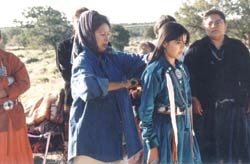Navajo Language and Culture
The navajo language has not only helped to preserve the Navajo culture but was also utilized as a U.S. Army code to disguise transmissions from the Japanese during World War II. Navajo arts continue to be passed on, as daughters and granddaughters learn weaving, basketmaking, pottery making, and jewelry making.
Different types of religion are practiced among the Navajo, a truly spiritual people.
There are the traditional Navajos who rely on medicine men, herbalists, ceremonies and other traditions to facilitate their practice.
Also, the Native American Church is chosen by some Navajos and is especially known for the ceremonial use of peyote for visions and cleansing.
Sweathouses are utilized by Navajos and other American Indian tribes, and Christianity is practiced by some Navajos who incorporate the Western religion with their native teachings.
Many Navajo children raised on the reservation continue to herd sheep and livestock.
Schools are accessible to most families, but sometimes it is necessary that
a family living many difficult miles away send the children to boarding school.
The Navajo today are not a pueblo people; rather they dwell a good
distance apart from each other in separate houses, though often in close
proximity to family. The Navajo appreciate and respect their culture as an
equal way of life to suburban America, and are proud of the simplistic ways
they cling to.

Kinaalda
A Navajo girl, upon reaching the age of 13 and experiencing her first menstrual period becomes initiated into womanhood by a beautiful 4-day ritual entitled the Kinaalda, which is part of the Navajo Blessing Way Ceremony. The Kinaalda literally translates "puberty ceremony," and this term is interchangeable with both the girl and the ceremony.
The Kinaalda is based on a myth about the first Kinaalda Ceremony performed by and for Changing Woman, who is the female deity identified with the Earth and she is the source and sustenance of all life on the earth's surface, controlling particularly fertility. During the Kinaalda the legendary origin and its transmission to mankind is retold and enacted. Although the Kinaalda ceremony is clearly a bridge, a rite of passage (as defined by Arnold van Gennep, in his term "rites de passage", as rites which accompany every change of place, state, social position and age, the ritual can be described in a new way.

